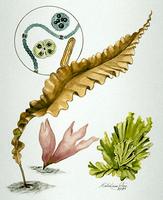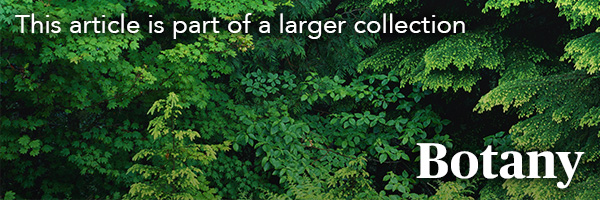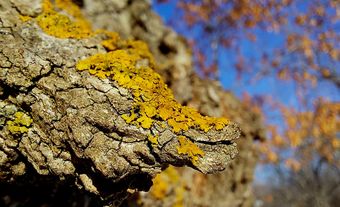
Algae
Algae comprise a taxonomically informal grouping of many simple, aquatic organisms as well as those living in damp habitats such as damp rock faces, tree trunks, moss hummocks or damp soil. A few even live endolithically (eg, within the pores of rocks) in deserts, relying upon nighttime dew for their source of moisture; others grow on melting snow or attached to the under surface of floating ice.
They are mostly photosynthetic organisms whose body is termed a thallus (ie; they lack leaves, stems and roots). All the photosynthetic forms possess chlorophyll a as their primary photosynthetic pigment. Algae also form unprotected reproductive structures. In some of the more morphologically advanced forms where conducting tissue is present, this tissue does not contain lignin, which is a compound typically found in the cell walls of woody plants.
Classification
This heterogeneous group of organisms collectively referred to as "algae " were at one time included entirely in the kingdom Plantae. With the present-day 5 kingdom classification, all the eukaryotic (cells having distinct nuclei) algae are now in the kingdom Protista, whereas the blue-green algae Cyanobacteria (formerly Cyanophyta) and Prochlorophyta are in the kingdom Monera with the other prokaryotic (cells having no distinct nuclei) organisms (eg, bacteria). Some phycologists (Gk, phykos, "seaweed"; logos, "discourse"), however, still consider algae to be plants.
Structure
Algal cells may be naked or may be covered by complete, rigid cell walls; incomplete cell walls (eg, a lorica or theca); or a series of plates, strips or inorganic and sometimes organic scales. Within these various coverings is the plasmalemma, a living structure responsible for controlling the inflow and outflow of materials in the cell protoplasm.
Reproduction
Many algae reproduce vegetatively through cell division or fragmentation, and many reproduce asexually through production of motile zoospores or nonmotile aplanospores. Spores are normally produced from unspecialized cells or specialized cells called sporangia.
Sexual reproduction is exhibited by many algae. Species may be homothallic or heterothallic, and they may display isogamy, anisogamy or oogamy. The Rhodophyta is an exception to other algae in that the male gamete does not possess flagella (eg, it is nonmotile). Fertilization results in a zygote. Some zygotes accumulate food reserves and develop thick, resistant cell walls and are able to withstand prolonged desiccation. Life histories may be predominantly haploid, with meiosis occurring when the zygote germinates, or predominantly diploid, where meiosis occurs prior to gamete formation.
Other algae exhibit either the alternation of isomorphic or heteromorphic generations (eg, the alternation of morphologically similar or dissimilar haploid and diploid generations respectively). In red algae the life cycle may consist of a haploid gametophyte, a diploid stage called the carposporophyte and a diploid tetrasporophyte.
Ecology
Algae have a worldwide distribution, growing wherever light and water are present. The obvious occurrences are along rocky coastlines of all continents (except Antarctica); as conspicuous floating masses (or scums) in particularly productive lakes and ponds; or attached to submerged rocks or larger aquatic plants in lakes, ponds and shallow rivers.
Canada's Pacific coast has a richer flora than the Atlantic coast, which generally has fewer and smaller species. Distribution on the inner coast differs from that of the open coast, primarily because of differences in salinity. Subarctic and arctic marine algae are more restricted in all ways. There is little growth in unprotected areas.
In Canadian marine areas, summer is characterized by the presence of large numbers of algae, the increase being especially noteworthy wherever ice masses occur in winter. The depths to which algae grow depend upon light penetration. In coastal estuaries, algae have reduced reproductive potential and are morphologically different from those of open waters.
Algal Systematics
The formal divisional taxon algae has long been abandoned, since the component groups are considered sufficiently distinct to warrant divisional status on the basis of comparisons between pigments, assimilatory (storage) products, flagella, cell wall chemistry and structure, as well as aspects of cell ultrastructure.
Electron microscopy has revealed structural characteristics now employed in algal systematics: flagella - their hairs, swellings, scales; chloroplasts, chloroplast endoplasmic reticulum, thylakoids, phycobilisomes, external organic and inorganic scales, silica deposition vesicles, theca; nuclear structure and division; and cell division. Simultaneously, biochemists have analyzed the molecular details of pigments, assimilatory products and cell walls. Today, 4 quite distinct evolutionary groups can be recognized as algae.
Prokaryotic algae (eg, Cyanobacteria, Prochlorophyta or Chloroxybacteria) were the first to evolve and have closer affinities to bacteria than other algal groups, even though some phycologists still consider them as algae.
Eukaryotic algae probably arose through a series of endosymbiotic relationships being developed. We can recognize 3 lines of evolution involving different endosymbioses. The first are those algae possessing a chloroplast envelope of 2 membranes (eg, Glaucophyta, which represent an intermediate stage in this evolutionary process, while red algae (Rhodophyta) and Chlorophyta represent the completion of this evolutionary process, resulting in the chloroplast).
The second are the eukaryotic algae, whose chloroplasts are surrounded by an additional membrane of chloroplast endoplasmic reticulum (eg, euglenoid flagellates, Euglenophyta; and dinoflagellates, Dinophyta).
The third are the eukaryotic algae, possessing 2 membranes of chloroplast endoplasmic reticulum, with the outer membrane of the chloroplast endoplasmic reticulum commonly being continuous with the outer membrane of the nuclear envelope. Between the chloroplast endoplasmic reticulum and the chloroplast envelope is a space containing tubules, ribosomes, and in the cryptophyta, reserve product (eg, Cryptophyta; diatoms, Bacillariophtya; golden brown algae, Chrysophyta; Prymnesiophyta; Xanthophyta; Eustigmatophyta; Rhaphidophyta; brown algae, Phaeophyta).
Blooms
The open waters, whether marine or freshwater, contain species that are too small to be seen without a microscope, except they do become visible when vast populations develop, as in eutrophic lakes, when "blooms" occur. Usually unicellular or colonial, these algae comprise phytoplankton (small, drifting aquatic plants), and are the primary food producers for zooplankton. In marine waters members of Dinophyta and Bacillariophyta predominate. Some species form "blooms", eg, some species of Dinophyta form red tides.
In inshore waters such as some BC coastal inlets, the Bay of Fundy or the St Lawrence estuary, dinoflagellates (Dinophyta) produce a toxin which may be concentrated by shellfish feeding on them. Eating such shellfish can cause paralysis, and even death to sea birds and mammals (including humans).
Habitats
Canada contains more than 25% of Earth's fresh water, mainly in lakes and rivers. Phytoplankton of lakes is well developed in open water and particularly evident in naturally productive as well as eutrophied lakes, when members of Cyanobacteria often dominate. The shallower areas are home to the benthic (bottom-dwelling) algae and rooted aquatic plants.
On the submerged sediments are epipelic algae; attached to the submerged plants as well as other algae are epiphytic algae; and attached to rocks and sand grains are epilithic and epipsammic algae respectively. More than 90% of algae species are found in benthic communities, and display some fascinating adaptations, eg, motile epipelic algae display endogenous vertical migration rhythms. Benthic algae are important primary producers in shallow lakes, ponds and rivers.
Algae can also live in aerial habitats providing sufficient moisture is available, eg, dry soil or within rock pores in deserts. In moist areas algae can be found growing upon tree trunks, mushrooms, mosses and liverworts; and upon stone, concrete and other non-natural objects. Some algae inhabit hot mineral springs; while some unicellular green algae grow in ice and snow, eg, red snow seen in summer in old, melting snowbanks in the mountains of BC and Alberta. A few algae grow in high concentrations of various chemicals (eg, sodium, magnesium, chlorine, sulphur) as in prairie water bodies that lose water only by evaporation.
A few algae live on (epizoic) or within (endozoic) animals, as well as other organisms. One green alga of the genus Cephaleuros is responsible for the red rust disease of tea plants. It is the most important disease of tea in some areas of the world; it can also cause economic losses in crops such as citrus and pepper.
Diatoms
Diatoms preserve very well in lake sediments because of their resistant siliceous cell wall. As a result they have been used extensively in reconstructing the past historical development of lakes. They have been used extensively in Eastern Canada to determine the extent of lake acidification. In western Canada they have been used to reconstruct lake level fluctuations, changes in lake trophic state and paleosalinity. In terms of lake level fluctuations and paleosalinity changes, diatoms are sensitive proxy indicators of climate changes.
Cell Walls
In general, cell walls comprise 2 components, an amorphous component which forms the matrix of the cell wall, and in which the fibrillar or second component is embedded. The fibrillar component forms the rigid skeleton of the cell wall, and is most commonly cellulose. The amorphous components are mainly polysaccharides, and those of some red and brown algae occur in amounts sufficient to be commercially exploited (eg, alginic acid, fucoidin, carragenan, prophyran, agar).
Nucleus
The nucleus in algae is surrounded by a double membrane nuclear envelope - as in other eukaryotic organisms - and contains DNA. There are 2 types of nuclei in algae. The first is found in the dinoflagellates (Dinophyta) and Euglenophyta, and is termed "mesokaryotic." The term is used to denote the evolutionary position of dinoflagellates and euglenoids between prokaryotes and eukaryotes. The remainder of the algae have an eukaryotic nucleus.
Pigments
Pigments are housed in chloroplasts. The basic structure of the photosynthetic apparatus comprises a series of flattened, membranous vesicles called the thylakoids which are within a matrix called the stroma. It is the thylakoids that contain the chlorophyll, and they are the sites of the photochemical reactions. Thylakoids can be free from one another or they can be stacked, depending upon the algal division. A pyrenoid with associated storage products may be present in a chloroplast.
Within the algae there are 4 types of chlorophyll a, b, c (c1 and c2) and d. Chlorophyll a is found in all photosynthetic algae, whereas chlorophyll b is confined to Euglenophyta and Chlorophyta. Chlorophyll c is found in Dinophyta, Cryptophyta, Rhaphidophyta, Bacillariophyta, Chrysophyta, Xanthophyta, Phaeophyta and Prymnesiophyta. Lastly, chlorophyll d is a minor component of many red algae.
As well as the chlorophyll pigments, other accessory pigments also occur within the chloroplasts. These are carotenoids (carotenes and xanthophylls), some of which are specific to only one division. These pigments occur in sufficient quantities in some groups to mask the green colour of the chlorophyll such that the cells appear brown or golden grown (eg, brown algae, diatoms). Water-soluble chromoprotein pigments called phycobiliproteins are found on the thylakoids of Cyanobacteria and Rhodophyta, and inside those of the Cryptophyta.
Flagella
Many unicellular and colonial algae, along with zoospores, possess flagella. Each flagellum is basically an extension of the cell membrane, comprising an internal axoneme of 9 doublet microtubules surrounding 2 doublets. The flagellum may be smooth or possess hairs or even scales. The different algal divisions have different flagella characteristics.
Morphology
Algae exhibit a diverse range of morphology, There are flagellate, motile unicells and colonies; others move in an amoeboid manner. Palmelloid forms also exist; these are nonmotile forms where amorphously shaped colonies develop with only the reproductive cells being motile. A variation of this is seen in the dendroind or "treelike" colonies. There are also algae which are unicellular but nonmotile. These are termed coccoid.
As with the motile forms, nonmotile colonies also exist. Some algae form unbranched and branched filaments, while others form parenchymatous and pseudoparenchymatous thalli. The most highly evolved type of habit is a heterotrichous habit where the thallus comprises a prostrate system anchoring the thallus to a substratum, with an erect system usually composed of branching filaments arising from it. Lastly, there is a siphonaceous or coenocytic habit, where the thallus grows in size without any septa being formed, except for production of reproductive structures.

 Share on Facebook
Share on Facebook Share on X
Share on X Share by Email
Share by Email Share on Google Classroom
Share on Google Classroom


